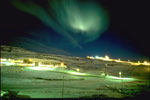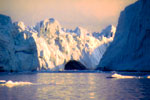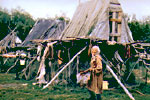In over 160 days of filming before awesome backdrops of ice and snow in Greenland, Canada, Alaska and Siberia, and under some of the most adverse condition imaginable with temperatures below minus 50 degrees, this film takes a fascinating look at the "Spell of the North".
In addition to following the exploratory history of this region over a period of 250 years, the documentary provides highly interesting insights into the lives today of man and beast in one of the most remote corners of the world.

The discovery of mummified Eskimos frozen in ice reveals fascinating insights into an age-old culture. The ice mummies are proof how similar the "real" Eskimos of today are to their ancestors. In his documentary, Axel Engstfeld reconstructs the story of Greenland's native peoples, follows their fate from the mysterious arrival and disappearance of the Vikings to the coming of the white man, who encouraged the Eskimos to hunt the coveted walrus and narwhal tusks for them, and very nearly destroyed their culture. The explorers quickly became the "White Masters", who then began a treacherous race to the North Pole. It is still disputed today, which of the two arch-rivals first reached the North Pole - Peary or Cook.
Part 1 of the documentary also takes a look at one of the frequently ignored chapters of Greenland's history - the 1950s when the United States set up its military base in Thule. After the crash of a U.S. transport plane carrying an atomic bomb, the region was radioactively contaminated.
Today, Greenland has a modern society and since 1979 also an autonomous administration after many decades under Danish colonial rule. The resources of the sea, which nourished and supported generations of Eskimos in the distant past, have again become one of the great hopes for the future of modern Greenland.

This segment of the documentary describes the adventurous expeditions to regions and cultures in the Arctic never before seen by European explorers. It describes the attempts to seize the treasures of northern Canada. What began as a courageous push into uncharted waters to discover an ocean route to China ended in fiasco for many a ship and its crew. The greatest disaster was the expedition under John Franklin in the mid-19th century which vanished in the ice without a trace. It was not until 140 years later that two men of the crew were discovered, frozen and preserved, in the polar ice. The examination of the corpses provided many clues about their mysterious disappearance.
Arctic exploration and history in Canada went hand-in-hand with one name: the Hudson's Bay Company. In existence for over 300 years it is one of the oldest companies in the world. For many years, the lucrative trade in furs changed the landscape and the people, making Indians and Eskimos dependent on goods from the White Man and his business deals. The Europeans back home soon lost interest in the search for the Northwest Passage. When the route was finally traversed for the first time in the early 20th century by the Norwegian Amundsen it had already lost its economic importance.
For a number of years, the provincial government of Quebec in Canada has been operating the largest hydroelectric project in North America with huge turbines and enormous reservoirs. The project has had severe consequences for the livelihood of the Cree Indians as well as for countless local plant and animal species. The Indians, however, have intensified their struggle to be heard and to defend their rights. The Eskimos, too, who call themselves "Inuit", are also on their way to a better future in a semi-autonomous territory in northern Canada. "Nunvut" - "Our Land" - is the name of the territory which is now the hope of coming generations and their culture.
.

In the early 18th century it was still a mystery whether or not the extreme northeastern edge of Asia was connected to America by a land bridge. Czar Peter the Great delegated the task of finding out to the Danish seafarer Vitus Bering - the "Czar's Columbus". In the course of a gigantic expedition, Bering discovered Alaska - "the big land" - as the natives called it. He was responsible for opening this vast stretch of land to Russian traders and hunters. However, they made slaves of the Aleuts and forced them mercilessly to hunt the sought-after otter pelts.
As profits declined, the Czar sold Alaska to the United States. What several U.S. Senators had originally referred to as the "most expensive refrigerator in the world" suddenly became the center of attention once the news of spectacular discoveries of gold made the rounds. Since then in Alaska, one "rush" after another has swooped down on this land of superlatives - after the gold rush, it was copper; then copper was followed by lumber, and lumber by oil.
Today, the oil arteries of the Alaska pipeline transport crude worth 40 million dollars - every day. But oil has also become a curse for Alaska. The supertanker Exxon Valdez ran aground in 1989 ravaging the sea and coastline where Vitus Bering had gone ashore 250 year earlier. The oil spill was the largest in U.S., history.
This segment of the documentary concludes with the varying perspectives of the Eskimos in Alaska and their Siberian neighbors on the other side of the Bering Strait. Because Moscow has more or less ignored the people of northeastern Russia since the collapse of the Soviet Union, the groups there are rediscovering their traditional culture and survival techniques. In Alaska, on the other hand, the Eskimos continue to evolve away from their old traditions, because oil and money have changed the way they live.

In the 16th century, as Spain and Portugal ruled the southern seas, the English and Dutch began the treacherous search for a Northeast Passage to China along the Siberian coast. Again and again, the pack ice put an end to these seafaring dreams. Among those who failed was also the famous captain, Willem Barents. It was not until the end of the 19th century, and thanks to a mild winter, that Nordenskjöld finally made it through in a steam-driven sailing ship. The Swedish captain not only discovered the Northeast Passage during this expedition, but also studied the native population that lived there.
Following in Nordenskjöld's footsteps, Fritz Baumann himself reached these aboriginal peoples in Siberia's northeast - the Chukchen and Siberian Eskimos. He describes their ancient culture, their relationships to animals, the hunting methods and their enigmatic mythology. He also examines how the Soviets forcibly resettled them in the 1950s and how they were pressed to adopt a foreign lifestyle, much like their distant neighbors on the island of Noviya Semlya, whose homeland was turned into a nuclear testing ground - with all the terrible consequences for the people and the environment.
Following the collapse of the Soviet Union, the Chukchen and Eskimos as well as other peoples in remote parts of Siberia have had to depend on themselves for the most part. Today, the last shred of hope for the older people are the children - children who were once educated in Soviet boarding schools. They hope that maybe they will come back and serve the tribes as doctors, lawyers and political leaders. And maybe even give these tiny ethnic minorities in Siberia a voice that will be heard and represented in the international community of nations.